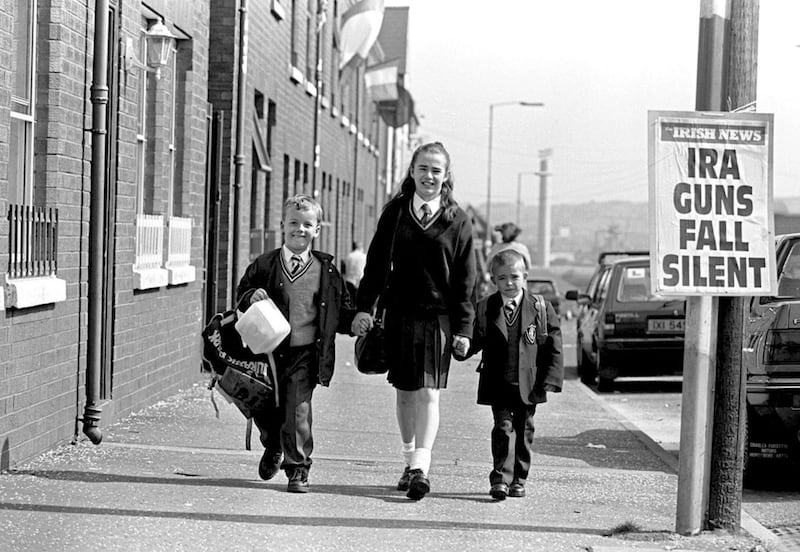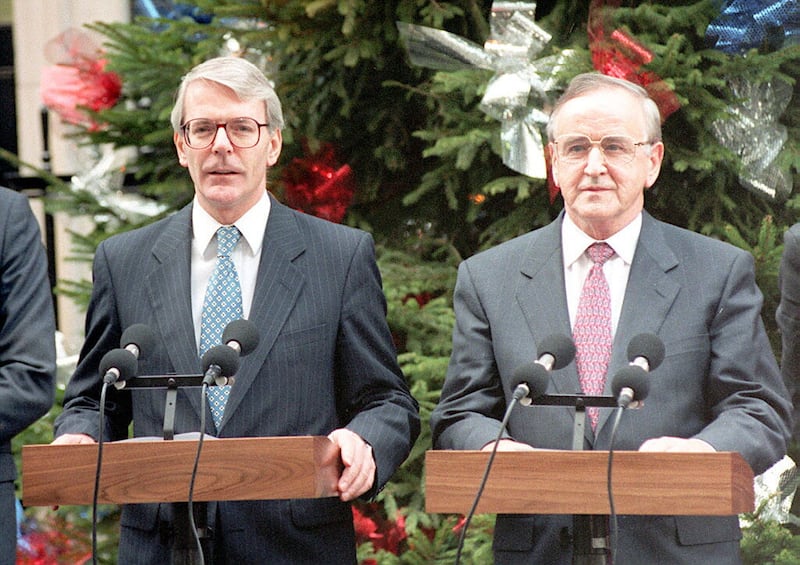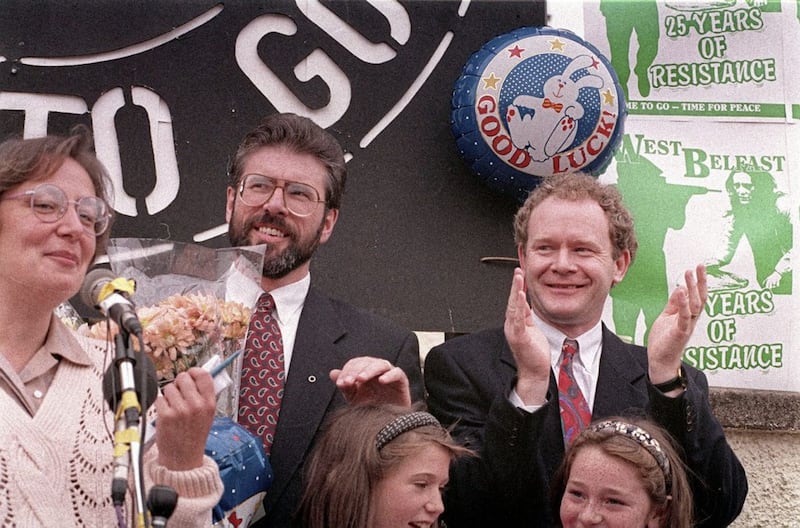It was on August 31 1994 that the IRA declared a “complete cessation” of violence.
Years of behind-the-scenes talks had come to fruition with the words read aloud by a select group of journalists: “In the last few minutes, the Provisional IRA has declared a complete and unequivocal ceasefire”.

For hundreds of families that year who had experienced death and devastation, it had come too late.
In the first eight months of 1994 alone, 118 had people died at the hands of paramilitaries, including three RUC officers and six Catholics gunned down watching a World Cup game in Loughinisland.
The ceasefire announcement had come amid months of speculation that the IRA was moving towards peace with secret talks held between the British and Irish governments, republicans and the input of the US administration.

Among the discussions being held were talks between then SDLP leader John Hume and then Sinn Féin president Gerry Adams.
Some of the foundations of the talks were laid by Fr Alec Reid, whose iconic image encapsulated the horror of the Troubles as he knelt to administer the last rites over the body of a British soldier.
In his role, he persuaded Mr Hume to engage in secret talks with Mr Adams, which initially took place at Clonard Monastery in west Belfast, with Fr Reid acting as mediator.
The late priest was later hailed as a man of courage whose greatest legacy was the part he played in setting Northern Ireland on the path to peace.

In was in March 1991 that the UUP, DUP, SDLP and Alliance Party agreed to roundtable talks, which later become known as the Brooke/Mayhew talks.
The following year, unionists attended talks with the Irish and British governments in London and UUP leader James Molyneaux later led a UUP delegation to Dublin for talks.
In 1993, a real shift towards political negotiation was made.
Taoiseach Albert Reynolds and British Prime Minister John Major published the Downing Street Declaration, which they said provided the foundation for a lasting political settlement.

“There is an opportunity to end violence for good in Northern Ireland,” Mr Major said at the time.
“We believe that it’s now up to those who have used or supported violence to take that opportunity.
“The door is open to them.”
In January 1994, US president Bill Clinton also approved a visa for Mr Adams to enter America, another move regarded as a way of smoothing the way to an IRA ceasefire.
The ceasefire announcement came 18 months after secret talks began between the British government and republicans and followed a joint April 1993 statement from Mr Hume and Mr Adams which accepted that unionists should be taken into account in any political settlement, but they must also accept a principle of Irish self-determination.
After months of discussions, the IRA leadership responded with the ceasefire announcement.
The ceasefire statement from `P O’Neill’ was delivered to security journalists including Eamonn Mallie and Brian Rowan in Belfast and Charlie Bird of RTÉ in Dublin on the morning of August 31 1994.

It read: “Recognising the potential of the current situation and in order to enhance the democratic process and underlying our definitive commitment to its success, the leadership of the IRA have decided that as of midnight, August 31, there will be a complete cessation of military operations. All our units have been instructed accordingly.
“At this crossroads the leadership of the IRA salutes and commends our volunteers, other activists, our supporters and the political prisoners who have sustained the struggle against all odds for the past 25 years. Your courage, determination and sacrifice have demonstrated that the freedom and the desire for peace based on a just and lasting settlement cannot be crushed. We remember all those who have died for Irish freedom and we reiterate our commitment to our republican objectives. Our struggle has seen many gains and advances made by nationalists and for the democratic position.
“We believe that an opportunity to secure a just and lasting settlement has been created. We are therefore entering into a new situation in a spirit of determination and confidence, determined that the injustices which created this conflict will be removed and confident in the strength and justice of our struggle to achieve this.
“We note that the Downing Street Declaration is not a solution, nor was it presented as such by its authors. A solution will only be found as a result of inclusive negotiations. Others, not the least the British government have a duty to face up to their responsibilities.
“It is our desire to significantly contribute to the creation of a climate which will encourage this. We urge everyone to approach this new situation with energy, determination and patience.”
Speaking previously about the intensity of the period of time leading up to the announcement, Mr Adams told of how “neither Martin (McGuinness) nor I really knew if we would succeed”.

“We were attempting something unique and exceptional - to construct a series of agreements which together could persuade the IRA leadership that there existed an alternative to armed actions capable of achieving republican goals.
“The danger was that if we pulled everything together and the army said `no’ then the process was over before it really started.”
Irish foreign minister Dick Spring described the statement as “historic” and met his government’s demand for an unconditional end to IRA violence.
But DUP leader Ian Paisley said the statement was an “insult to the people [the IRA] has slaughtered because there was no expression of regret”, while UUP leader James Molyneaux insisted the word “permanent” was needed in the ceasefire declaration.
Within weeks of the IRA ceasefire, loyalist paramilitaries followed suit with former UVF leader Gusty Spence confirming they would cease “all operational hostilities”.
However, the IRA ceasefire did not hold and ended when a huge bomb exploded in Canary Wharf in February 1996.
In July 1997, the IRA called another ceasefire, which paved the way for Sinn Féin’s inclusion in negotiations that led to the signing of the Good Friday Agreement in April 1998.








